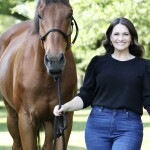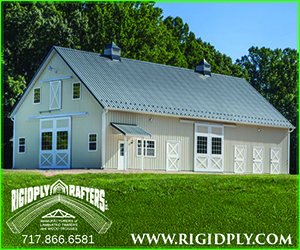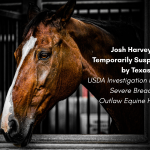A Tribute to the OTTB Horses
Listen to the Horse Talk Podcast's Tribute to Thoroughbreds:
BushHog, MerryDan, OunceOfLuck, BuckontheGo, Fire Makers Star, HowGreatThouArt; these were and are my family’s Jockey Club Thoroughbreds. These Off-The-Track-Thoroughbreds made me the equestrian I am today, and some are still shaping me as a rider, but most of all a person.
The days of seeing Thoroughbreds as a leading breed in the show ring are gone. Now, there are incentive programs for Thoroughbreds in about every discipline to help rebuild and rebrand these once leading sport horses as reliable, competitive, versatile and suitable choices for equestrians who are looking for a show and competition horse.
Thoroughbreds are not better than other breeds, and other breeds are not better than them. Every rider is not suited to own or ride a Thoroughbred, and I believe as horsemen and horsewomen we should always be accepting, encouraging and celebrating all breeds in open competition divisions and shows. In my opinion, the more the merrier.
But what makes the Thoroughbred a fantastic choice as a sport horse? There are several things and many well known competitors, olympians, and trainers have said “There’s just something special about the Thoroughbred,” but if you want to know my personal opinion, based on my personal experiences, then keep reading.
I’m an amateur rider, but my “green” Thoroughbreds have given me a sensitivity, a feel, a confidence and an awareness needed as a rider to ride many different types of horses. BushHog, aka Sampson, was my sister, Ashlee’s Children’s Hunter horse. He was a beautiful blood bay with a striking head. He had perfectly set ears (or devil horns as we remember them). My mom bought him for Ashlee when she was 12 and she has always said, “I bought him because I knew if I didn’t his next stop was the kill pen.” He had horrible rain rot, corns on his feet from ill fitted racing plates and you could count every rib.
If you are as old as me and grew up in the greater Memphis area then you probably remember Dr. Andy Livingston. When he first looked at Sam he took a deep sigh, asked our mom, “Are you sure?” and when she nodded he knew this was more about saving a horse then finding a show horse. He then said, “Well, let’s get him under saddle and see how he moves.” After seeing him work in the ring my mom said Dr. Livingston lit up and said, “Well, that’s not bad, I think we can work with this! Let’s put weight on him and work on his feet.”
Soon after rehabbing his feet and putting weight on Sam, 12-year-old Ashlee was on the back of her Children’s Hunter. The other kids at the barn were terrified of Sam. He’d squeal and turn circles coming in from the pasture. He’d snort at the stall door for his food, and trail ride, forget it! He’d overjump so much that he’d send you flying through the air, the kind of dismount where you’d see your feet flip over your head at least five times before coming to a slow roll.
But, when you have a mother who was a horsewomen like we had, this was something you worked through with your horses. You learned and evolved with them. You see, our mom rode and showed all the horses no one else would. She rode the horses only trainers rode. She rode the rejects, the hot ones, the problem ones and she would take them into the show ring and win. She had a World Champion whose photograph sits in the Hall of Fame at the Kentucky Horse Park. She was born into a Thoroughbred Racing family and that calmness she had when riding was something she knew Thoroughbreds would teach her children.
Ashlee always got back on Sam and when they would connect and hit every jump at the perfect spot with his rhythmic canter, and when he’d change his elegant and natural lead changes, they would always place in the top of large classes with over 15 riders. Sam taught Ashlee how to manage stress, how to remain steady and calm no matter the size of his jump or twirl around her on the ground. And riding an athletic horse like Sam proved to her that she knew how to ride and handle a horse other riders wouldn’t come near. He was also the first horse I sat on and started riding at six years old. And, naturally, the first horse that bucked me off. He shared with me the sensation of my feet flipping over my head at least five times before finally coming to a slow roll. Thanks for that right of passage Sam!
MerryDan, aka Sketch, became my trusted mount. He was a 14.2 large Thoroughbred pony, and was a striking dappled gray. He was my heart horse from the time I was 10 until my twenties. He would never bolt and buck you off, but he was sensitive, hard in the mouth, and you never had to ask him to move off your leg, but he was spooky.
He was gentle but if a leaf passed by his outside eye he’d leap his entire body off the rail and into the middle of the ring without missing a single step. Teaching a kid how to properly ride a spook was his expertise. I loved that horse. We connected so deeply that when I thought it he'd do it. I don’t know if I will ever find another horse like him. We jived perfectly and it made me fall in love with the sensitive horses.
He taught me to be centered and balanced. He taught me to be a quiet rider and how to be aware of his body, my body and our surroundings. He taught me to be calm and keep my own nerves in check if he spooked. He taught me how to be fluid in the moment and let things roll off. He molded me into a laid back and forgiving rider and how to keep my emotions under control.
Ounceofluck, aka Gage, was my first personal horse that I got to train completely. He came out of Keeneland and was used as a break away horse. He is a solid, big boned, flashy chestnut Thoroughbred and the biggest horse I sat on at the time. He stands at 16.3 hands. Gage required a good amount of leg, a big change from Sketch. He has a fabulous rhythmic trot but his canter, yikes. His stride was almost too big and getting him fit and balanced behind was always the hardest thing for me to do as his rider.
I took him over his first jumps and man, what a fabulous jump he had. I really loved to jump this horse. Once he built more balance behind he always got to the perfect spots. He moved around the course with his ears up and forward, but where we really loved to work was out in an open pasture. He was fabulous working over hundreds of acres with and without company. He took me over our first cross country jumps and I crossed trained him because he was steady, trusting and bold. He however, needed consistency. He bucked me off probably five times, maybe more now that I’m actually counting. He was the hardest horse I have ridden to date. He taught me how to give more pressure and when to stop once things came together. My only regret is I trained him in my young adult years, when life was more about socializing than focusing on evolving myself as a rider. As much as he was a gentleman on the ground, he could always humble my 20-year-old ego, and man, do we all need that horse, the one that humbles us!
Buck on the Go, aka Bucky, was Ashlee’s first horse again after Sam passed away. He was a 15.3 hand bay and he came to us as a three year old. We soon realized he had anhidrosis and that brought a level of horse health knowledge and care that he needed in order to live as long as he did. Bucky was sweet, with his people. He’d sneer at you when walking past his stall, but it was all for show. He was naturally balanced, soft in his mouth, a little trooper we called him. He was the perfect Children’s horse. He passed away at 17-years-old and we always suspected he had a compromised immune system with being anhidrosis, but he was one that learned quickly, behaved wonderfully under saddle, and had tons of personality.
Fire Makers Star, aka Kevin, and HowGreatThouArt, aka Evan, are our new OTTBs. We did not plan their names to rhyme by the way! They are both seven and were restarted and retrained in a completely different training program than any of our other horses. They are two totally different horses, but with steady consistency and desensitizing groundwork they are proving to be lovely sport horses. I am extremely proud of their advancements and it has made me see how restarting and retraining OTTBs has evolved over the last thirty years. There are many different ways to train horses and restart them for new careers. One method isn’t better than the other, but some are more suited for specific types of horses and I think we finally found a great training program for our OTTBs.
Our Thoroughbreds have taught us more about ourselves and who we want to be, than what we have taught them. Our Thoroughbreds have taught us grit and resilience. They have humbled our egos and honestly we don’t feel the need to show our skills to the world; we are happy right here at home, hacking in our rings and fields and enjoying their companionship. They’ve taught us how to be accepting, how to have grace, how to be forgiving, how to focus on one task at a time, how to be aware of the energy we are putting into them, and how to soften our asks. They have taught us all about proper nutrition, how to care for hard keepers, seniors, and ones with degenerative illnesses. They have taught us patience, and how horses and this sport is a roller coaster of experiences and emotions. They have taught us how to grieve and they have helped us heal. They’ve given us their hearts on our worst days, and shown us compassion and empathy.
Any breed can do this, but, if you ask me, there is just something special about a Thoroughbred.









